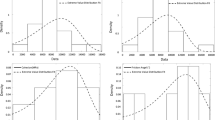Summary
A two-dimensional finite difference computer program, with the facility to represent stratified material by means of a mesh of ‘mass points’ with different material properties in each square of the mesh, is adapted to run on a mesh whose material properties are selected stochastically from a specified distribution. The program uses an iterative method to solve the equations of equilibrium, giving estimates of displacements and stresses.
Lattices of normally distributed (zero mean, unit variance) random values are produced: lattices of statistically independent values and lattices whose values are spatially correlated, to give the effect of gradual variations resulting in regions of positive values and regions of negative values.
These lattices are used to generate the material properties: Young's modulus, Poisson's ratio and density. Each property has a specified mean and standard deviation for each material in the model, and the precise values for each mass point are calculated from the relevant lattices.
A simple model with a square opening is used to investigate the effect of this stochastic generation of material properties, by comparison of stresses and displacements near the opening for runs of the program with (1) deterministic and (2) stochastic properties.
Similar lattices of random values are used to introduce a stochastic element in the criterion for failure of materials. This is applied to a more realistic simulation of a mining situation, where Mohr's Criterion is used, with a stochastic component, to determine whether failure has occurred at each point of the mesh.
Similar content being viewed by others
References
Besag, J. (1974) Spatial interaction and the statistical analysis of lattice systems,Journal of the Royal Statistical Society B36, 192–225.
Box, G.E.P. and Muller, E. (1958) A note on the generation of random normal deviates,Annals of Mathematical Statistics 29, 610–1.
Isaac, A.K., Smart, B.G.D., Mayer, A.D. and Neve, P. (1983) Finite difference methods for modelling elastically dissimilar strata, inProceedings of the Fourth International Conference on Mathematical Modelling, Zurich, August.
Koh, N.H. (1977)A Survey of Random Sample Generation for Simulation, MSc dissertation, University of Wales, Cardiff.
Mahtab, M.A., Bolstad, D.D., Alldredge, J.R. and Shanley, R.J. (1972)Analysis of Fracture Orientations for Input to Structural Models of Discontinuous Rock, Bureau of Mines report of investigations 7669, Denver Mining Research Centre, Denver, Colorado.
Mayer, A.D. (1981)The Development of Theoretical and Stochastic Modelling as an Aid to the Prediction of Strata Behaviour, PhD thesis, University of Wales, Cardiff.
Neave, H.R. (1973) On using the Box-Muller transformation with multiplicative congruential pseudorandom number generators,Applied Statistics 22, 92–7.
Su, Y.L., Wang, Y.J. and Stefanko, R. (1969) Finite element analysis of underground stresses utilizing stochastically simulated material properties, inProceedings of the 11th Symposium on Rock Mechanics, Berkeley.
Author information
Authors and Affiliations
Rights and permissions
About this article
Cite this article
Mayer, A.D., Isaac Stochastic methods for the prediction of strata behaviour. International Journal of Mining Engineering 2, 291–304 (1984). https://doi.org/10.1007/BF00881118
Received:
Issue Date:
DOI: https://doi.org/10.1007/BF00881118




